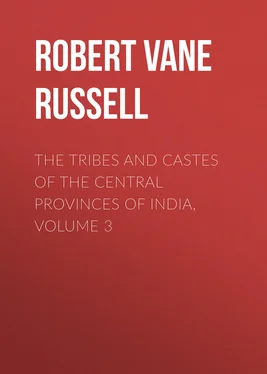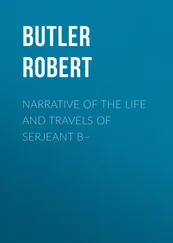Robert Vane Russell - The Tribes and Castes of the Central Provinces of India, Volume 3
Здесь есть возможность читать онлайн «Robert Vane Russell - The Tribes and Castes of the Central Provinces of India, Volume 3» — ознакомительный отрывок электронной книги совершенно бесплатно, а после прочтения отрывка купить полную версию. В некоторых случаях можно слушать аудио, скачать через торрент в формате fb2 и присутствует краткое содержание. Жанр: foreign_prose, История, foreign_edu, foreign_antique, на английском языке. Описание произведения, (предисловие) а так же отзывы посетителей доступны на портале библиотеки ЛибКат.
- Название:The Tribes and Castes of the Central Provinces of India, Volume 3
- Автор:
- Жанр:
- Год:неизвестен
- ISBN:нет данных
- Рейтинг книги:5 / 5. Голосов: 1
-
Избранное:Добавить в избранное
- Отзывы:
-
Ваша оценка:
- 100
- 1
- 2
- 3
- 4
- 5
The Tribes and Castes of the Central Provinces of India, Volume 3: краткое содержание, описание и аннотация
Предлагаем к чтению аннотацию, описание, краткое содержание или предисловие (зависит от того, что написал сам автор книги «The Tribes and Castes of the Central Provinces of India, Volume 3»). Если вы не нашли необходимую информацию о книге — напишите в комментариях, мы постараемся отыскать её.
The Tribes and Castes of the Central Provinces of India, Volume 3 — читать онлайн ознакомительный отрывок
Ниже представлен текст книги, разбитый по страницам. Система сохранения места последней прочитанной страницы, позволяет с удобством читать онлайн бесплатно книгу «The Tribes and Castes of the Central Provinces of India, Volume 3», без необходимости каждый раз заново искать на чём Вы остановились. Поставьте закладку, и сможете в любой момент перейти на страницу, на которой закончили чтение.
Интервал:
Закладка:
In order to injure an enemy they will make an image of him in clay, preferably taken from underneath his footprint, and carry it to the cemetery. Here they offer red lead, red thread, bangles, and various kinds of grain and pulse to the ghosts and say to them, “Male and female deities, old and newly buried, maimed and lame, spirits of the wind, I pronounce this charm with your help.” Then they pierce the figure with arrows in the chest and cut it with a knife in the region of the liver and think that their enemy will die. Another method is to draw the likeness of an enemy on cloth with lime or charcoal, and bury it in a pot in front of his house on a Sunday or Tuesday night so that he may walk on it in the morning, when they hope that the same result will be achieved.
In order to breed a quarrel in an enemy’s house they get the feathers of a crow, or the seeds of the amaltās , 73 73 Cassia fistula.
or porcupine needles, and after smoking them over a fire in which some nails have been placed, tie them to the eaves of his house, repeating some charm. The seeds of the amaltās rattle in their pods in the wind, and hence it is supposed that they will produce a noise of quarrelling. Porcupine’s quills are sharp and prickly, and crow’s feathers are perhaps efficacious because the crow is supposed to be a talkative and quarrelsome bird. The nails in the fire, being sharp-pointed, may be meant to add potency to the charm. One who wishes to transfer sickness to another person obtains a cloth belonging to the latter and draws two human figures on it, one right side up and the other upside down, in lamp-black. After saying charms over the cloth he puts it back surreptitiously in the owner’s house. When people are ill they make a vow to some god that if they recover they will sacrifice a certain number of animals proportionate to the severity of the illness. If the patient then recovers, and the vow is for a larger number of animals than he can afford, he sets fire to a piece of forest so that a number of animals may be burnt as an offering to the god, and his vow may thus be fulfilled. This practice has no doubt gone out owing to the conservation of forests.
47. Omens
If a Gond, when starting on a journey in the morning, should meet a tiger, cat, hare, or a four-horned deer, he will return and postpone his journey; but if he meets one of these animals when he is well on the way it is considered to be lucky. Rain falling at a wedding or some other festival is believed to be unlucky, as it is as if somebody were crying. In Mandla, if a cock crows in the night, a man will get up at once, catch it and twist its neck, and throw it over the house as far away as he can. Apparently the cock is supposed to be calling to evil spirits. If a hen cackles, or lays eggs at night, it is also considered inauspicious, and the bird is often killed or given away. They think they can acquire strength by carrying the shoulder-bones of a tiger on their shoulders or drinking a little of the bone-dust pounded in water. If there is disease in the village, the Bhumka or village priest performs the ceremony of Gaon bāndhna or tying up the village. Accompanied by a party of men he drives a pig all round the village boundary, scattering grains of urad pulse and mustard seed on the way. The pig is then sacrificed, its blood is sprinkled on all the village gods, and it is eaten by the party. No man or animal may go outside the village on the day of this ceremony, which should be performed on a Sunday or Wednesday. When cattle disease breaks out the Bhumka makes an arch of three poles, to which is hung a string of mango leaves, and all the cattle of the village are driven under it to avert the disease.
48. Agricultural superstitions
When there is drought two boys put a pestle across their shoulders, tie a living frog to it with a rag, and go from house to house accompanied by other boys and girls singing:
Mendak Bhai pāni de,
Dhān, kodon pakne de,
Mere byāh hone de,
or ‘Brother Frog give rain; let the rice and kodon ripen; let my marriage be held.’ The frog is considered to be able to produce rain because it lives in water and therefore has control over its element. The boy’s point in asking the frog to let his marriage be held is that if the rains failed and the crops withered, his parents would be unable to afford the expense. Another method of obtaining rain is for two naked women to go and harness themselves to a plough at night, while a third naked woman drives the plough and pricks them with a goad. This does not appear capable of explanation on any magical basis, so far as I know, and the idea may possibly be to force the clemency of the gods by showing their extraordinary sufferings, or to show that the world is topsy-turvy for want of rain. A leather rope is sometimes tied to a plough and harrow, and the boys and girls pull against one another on the rope in a tug-of-war. If the girls win they think that rain will soon come, but if the boys win that it will not. In order to stop excessive rain, a naked bachelor collects water from the eaves in a new earthen pot, covers the pot with a lid or with mud, and buries it beneath the earth; or the pot may be filled with salt. Here it may perhaps be supposed that, as the water dries up in the pot or the salt gets dry, so the rain will stop and the world generally become dry. The reason for employing women to produce rain, and men to stop it, may be that women, as they give milk, will be more potent in obtaining the other liquid, water. Nakedness is a common element in magic, perhaps because clothes are considered a civilised appanage, and unsuitable for a contest with the powers of nature; a certain idea of impurity may also attach to them. If a crow in carrying a straw to build its nest holds it in the middle, they think that the rains will be normal and adequate; but if the straw is held towards one end, that the rains will be excessive or deficient. If the titahri or sandpiper lays four eggs properly arranged, they think that sufficient rain will fall in all the four monsoon months. If only one, two or three eggs are laid, or only this number properly placed in the nest and the others at the side, then the rains will be good only in an equivalent number of months.
At the beginning of the harvest they pluck an ear of corn and say, ‘Whatever god is the guardian of this place, this is your share, take it, and do not interfere.’ The last plants in the field are cut and sent home by a little girl and put at the bottom of the grain-bin of the house. Chitkuar Devi is the goddess of the threshing-floor, and before beginning to winnow the grain they sacrifice a pig and a chicken to her, cutting the throats of the animals and letting their blood drop on to the central post of the threshing-floor. When they are about to take the kodon home, they set aside a basketful and give it to the sister’s son or sister’s husband of the owner, placing a bottle of liquor on the top, and he takes it home to the house, and there they drink one or two bottles of liquor, and then begin eating the new grain.
49. Magical or religious observances in fishing and hunting
In Mandla the Gonds still perform, or did till recently, various magical or religious rites to obtain success in fishing and hunting. The men of a village were accustomed to go out fishing as a communal act. They arrived at the river before sunrise, and at midday their women brought them pej or gruel. On returning the women made a mound or platform before the house of the principal man of the party. All the fish caught were afterwards laid on this platform and the leader then divided them, leaving one piece on the platform. Next morning this piece was taken away and placed on the grave of the leader’s ancestor. If no fish were caught on the first day, then on the next day the women took the men no food. And if they caught no fish for two or three days running, they went and dug up the platform erected in front of the leader’s house and levelled it with the ground. Then the next morning early all the people of the village went to another village and danced the Sela dance before the tombs of the ancestors of that village. Sometimes they went on to a third village and did the same. The headman of the village visited levied a contribution from his people, and gave them food and drink and a present of Rs. 1–4. With this they bought liquor, and coming back to their own village, offered it in front of the platform which they had levelled, and drank it. Next morning they went fishing again, but said that they did not care whether they caught anything or not, as they had pleased their god. Next year all the people of the village they had visited would come and dance the Sela dance at their village the whole day, and the hosts had to give the visitors food and drink. This was said to be from gratitude to the headman of the other village for placating their god with an offering of Rs. 1–4. And the visit might even be repeated annually so long as the headman of the other village was alive. Apparently in this elaborate ritual the platform especially represented the forefathers of the village, whose spirits were supposed to give success in fishing. If the fishers were unsuccessful, they demolished the platform to show their displeasure to the spirits, and went and danced before the ancestors of another village to intimate the transfer of their allegiance from their own ancestors to these latter. The ancestors would thus feel themselves properly snubbed and discarded for their ill-nature in not giving success to the fishing party. But when they had been in this condition for a day or so the headman of the other village sent them an offering of liquor, and it was thus intimated to them that, though their own descendants had temporarily transferred their devotion, they were not entirely abandoned. It would be hoped that the ancestors would lay the lesson to heart, and, placated by the liquor, be more careful in future of the welfare of their descendants. The season for fishing was in Kunwār and Kārtik, and it sometimes extended into Aghan (September to November). During these months, from the time the new kodon was cut at the beginning of the period, they danced the Sela, and they did not dance this dance at any other time of the year. 74 74 This is incorrect, at present at any rate, as the Karma is danced during the harvest period. But it is probable that the ritual observances for communal fishing and hunting have now fallen into abeyance.
At other seasons they would dance the Karma. The Sela dance is danced by men alone; they have sticks and form two circles, and walk in and out in opposite directions, beating their sticks together as they pass. Sometimes other men sit on the shoulders of the dancers and beat their sticks. Sela is said to be the name of the stick. In the Sela dance the singing is in the form of Dadaria, that is, one party recites a line and the other party replies; this is not done in the Karma dance, for which they have regular songs. It seems possible that the Sela dance was originally a mimic combat, danced before they went out to fight in order to give them success in the battle. Subsequently it might be danced before they went out hunting and fishing with the same object. If there was no stream to which they could go fishing they would buy some fish and offer it to the god, and have a holiday and eat it, or if they could not go fishing they might go hunting in a party instead. When a single Gond intends to go out hunting in the forest he first lights a lamp before his household god in the house, or if he has no oil he will kindle a fire, and the lamp or fire must be kept burning all the time he is out. If he returns successful he offers a chicken to the god and extinguishes the lamp. But if he is unsuccessful he keeps the lamp burning all night, and goes out again early next morning. If he gets more game this time he will offer the chicken, but if not he will extinguish the lamp, put his gun outside and not touch it again for eight days. A Gond never takes food in the morning before going out hunting, but goes out in a fasting condition perhaps in order that the god, seeing his hunger, may send him some game to eat. Nor will a Gond visit his wife the night before he goes out hunting. When a Baiga goes out hunting he bangs his liquor-gourd on the ground before his household god and vows that, if successful, he will offer to the god the gourd full of liquor and a chicken. But if he returns empty-handed, instead of doing this he fills the gourd with earth and throws it over the god to show his wrath. Then if he is successful on the next day, he will scrape off the earth and offer the liquor and chicken as promised. A Baiga should worship his god and go out hunting at the new moon, and then he will hunt the whole month. But if he has not worshipped his god at the new moon, and still goes out hunting and is unsuccessful, he will hunt no more that month. Some Gonds before they go hunting draw an image of Mahābīr or Hanumān, the monkey god and the god of strength, on their guns, and rub it out when they get home again.
Интервал:
Закладка:
Похожие книги на «The Tribes and Castes of the Central Provinces of India, Volume 3»
Представляем Вашему вниманию похожие книги на «The Tribes and Castes of the Central Provinces of India, Volume 3» списком для выбора. Мы отобрали схожую по названию и смыслу литературу в надежде предоставить читателям больше вариантов отыскать новые, интересные, ещё непрочитанные произведения.
Обсуждение, отзывы о книге «The Tribes and Castes of the Central Provinces of India, Volume 3» и просто собственные мнения читателей. Оставьте ваши комментарии, напишите, что Вы думаете о произведении, его смысле или главных героях. Укажите что конкретно понравилось, а что нет, и почему Вы так считаете.












